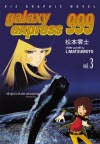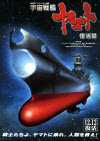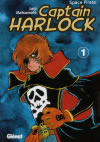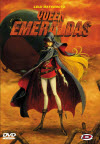Leiji Matsumoto: Yamato Spirit
The artist of Space Battleship Yamato talks to Jonathan Clements and Motoko Tamamuro about his life and work.
“The most terrifying thing in the creative world is pallid imitation. If your creation looks like somebody else’s work, it’s no use. You have to establish your own world, otherwise it’s not worth calling it creative work. Everything starts with a copy, but you can apply, you can improve, you can develop, and then you’re creating for yourself. I started drawing weekly manga serials when I was young, but I’ve seen many corpses in heaps at the foot of the wall of creativity.”
 It’s past midnight, and the interview is winding down, but manga creator Leiji Matsumoto is still speaking at full throttle. Surrounded by the dregs of a birthday party, the creator of Space Battleship Yamato, Captain Harlock and Galaxy Express 999 is passionately, urgently keen to make sure that nobody is offended.
It’s past midnight, and the interview is winding down, but manga creator Leiji Matsumoto is still speaking at full throttle. Surrounded by the dregs of a birthday party, the creator of Space Battleship Yamato, Captain Harlock and Galaxy Express 999 is passionately, urgently keen to make sure that nobody is offended.
“Please,” he says, “avoid all expressions that might hurt the feelings of people in Britain. Or anywhere else! Human beings are the same. I respect them all, and I am honoured that my work travels abroad and is read there.”
From the very outset, Matsumoto had an eye on potential foreign audiences. “My aim was always to write stories that would not offend anyone in any country, but would entertain them. I’ve become really hyper-sensitive about it.” It was, after all, Matsumoto himself who suspended an anime production based on his work, when he discovered that the animators were using the Star of David as a symbol of evil.
Matsumoto traces much of his motivation to his childhood. Born in 1938, he was reared on samurai ethics and Japanese folktales, but in a world where the old order was soon turned upside down. His father was one of Japan’s pioneer pilots, who had trained between the wars with aggressor squadrons in France. In the aftermath of WW2, the family lived in poverty, but surrounded with unprecedented access to new cultures and philosophies.
The young Matsumoto subsisted on American comics from the nearby airbase, and an oddly eclectic mix of movies. “I am hugely influenced by things I saw when I was a child. There’s a scene in the New Tales of the Heike, where the clan leader Taira no Kiyomori is defeated at the end. The victors are wearing white clothes with red sashes, and dancing under the cherry blossoms. But he glares at them and says: ‘Dance… dance… but tomorrow belongs to me.’ He smiles, and then the film is over. I loved that. And in Gone with the Wind, just before the intermission, Scarlett goes to the fields at night, and says: ‘I will never be hungry again.’ Back then there was hardly any food, and those words stuck with me. And at the end she says ‘Tomorrow is another day,’ but in Japanese it’s not that, it comes out as something like ‘Tomorrow’s wind will blow tomorrow.’ It had a huge impact on me.
“If I had money, I didn’t buy lollipops. I spent it on foreign books. From the mid-1950s, it started with American comics. When I discovered the true face of H.G. Wells and [Japanese science fiction author] Juza Unno, I was terrified. I’d thought Wells was ‘just’ a science fiction writer, until I realised he was a scholar. Unno was an electrical engineer. Unless you have that kind of grounding, you can’t write science fiction. So that was a real terror for me. People often derided me for not having ‘enough’ comics experience to become a comics artist. I’d say: ‘I don’t have time to read comics!’ I was very cocky about it. If I wanted to write fantasy or science fiction, I needed real knowledge! I started to believe I shouldn’t have read comics when I was small. Instead, I scavenged for books. I read about hydromechanics and rocket engineering… things like that.”
Matsumoto was still a teenager, only a couple of months out of school in Kyushu, when his submissions to Tokyo manga magazines piqued editors’ interest. Already displaying talent for art and writing, his only problem was geographical — the fast turnarounds of serial magazines did not favour commissioning by post. Summoned to Tokyo, he pawned his record collection, borrowed money against his future sales and got on the train.
“I decided not to come home even if it killed me. The distance was so far that once in Tokyo it would not be easy to go home. I had only 700 yen left in my pocket. The journey took 24 hours, by steam train.” Matsumoto travelled through post-war Japan, with wartime destruction still obvious even in the 1950s, but the trains were still running. In later work, he would use this epic journey as the inspiration for Galaxy Express 999, in which an annual train takes passengers through space to Andromeda.
Matsumoto was determined to draw fantasy, but found himself with little control over his choice of subject matter. With the boys’ comics medium crowded with big names, he spent a reluctant five years drawing women’s manga. “I ended up writing many European-themed stories,” he confesses, “but I didn’t know much about women’s everyday life. I didn’t even know how they dressed themselves.”
Drawing under his real name, Akira Matsumoto, he dragged fantastic themes into his work, sometimes subversively. The Adventures of Tiger-stripe Mime, an unassuming kid’s comic about a cat, had a protagonist named after Mime from Wagner’s Ring Cycle. His acclaimed Maria from the Silver Valley began as a medieval romance, but soon became a meditation on the stand-off between our world and Faery, and the lost continent of Mu.
Yamato
 A decade later, the arrival of a generation of female creators who had grown up reading manga ousted most men from women’s comics. By this time, Matsumoto’s reputation was firm enough that he could move into the “boy’s” genre of science fiction, although he still cherished the idea of working for an older audience. An early success was Otoko Oidon, a chronicle of life for an impoverished student dropout; another was The Cockpit, a series of war stories beginning with Iron Cross of Africa in 1969. Matsumoto also worked as an illustrator, most notably for Japanese collections of the Northwest Smith and Jirel of Joiry stories by C.L. Moore. This proved to be his big break, beginning in magazines in 1968, and gaining a greater permanence when republished in the 1970s in book form. Matsumoto’s cover art and internal illustrations swiftly established him with a dual expertise in space opera imagery and lissome heroines. This led to the anime producer Yoshinobu Nishizaki hiring Matsumoto on a conceptual artist on a new project.
A decade later, the arrival of a generation of female creators who had grown up reading manga ousted most men from women’s comics. By this time, Matsumoto’s reputation was firm enough that he could move into the “boy’s” genre of science fiction, although he still cherished the idea of working for an older audience. An early success was Otoko Oidon, a chronicle of life for an impoverished student dropout; another was The Cockpit, a series of war stories beginning with Iron Cross of Africa in 1969. Matsumoto also worked as an illustrator, most notably for Japanese collections of the Northwest Smith and Jirel of Joiry stories by C.L. Moore. This proved to be his big break, beginning in magazines in 1968, and gaining a greater permanence when republished in the 1970s in book form. Matsumoto’s cover art and internal illustrations swiftly established him with a dual expertise in space opera imagery and lissome heroines. This led to the anime producer Yoshinobu Nishizaki hiring Matsumoto on a conceptual artist on a new project.
Nishizaki, who died in November 2010, was a controversial, hard-nosed businessman who wanted to lift anime out of its early 1970s recession. The nature of his collaboration with Matsumoto has been hotly debated ever since, and became the subject of a prolonged lawsuit. Nishizaki, working with the science fiction authors Keisuke Fujikawa and Aritsune Toyota, had brainstormed a desperate quest through space — a one-way mission against the odds. But it was Matsumoto who fleshed it out into Space Cruiser Yamato (1974), a last-ditch dash to save a ruined Earth, using a spacecraft built inside the hulk of a famous WW2 battleship. Known in the English-speaking world as Star Blazers, Yamato was an icon of 1970s TV SF, with an acknowledged influence on Star Trek: The Next Generation and Battlestar Galactica. The prolonged feud between Nishizaki and Matsumoto revolved around who had come up with what: later to be an important issue in the era of remakes and merchandising.
After years of argument, it was determined that Nishizaki owned the name Yamato and the high concept. Matsumoto was the inventor of the look of the series: its iconic uniforms and characters, and an almost diesel-era technology where spaceships needed to fixed with hammers, inspired by his own love of WW2 machinery. His concept art, storyboards and two-volume manga spin-off were vital influences on the first series of Yamato, and undeniably his own. In the case of the love-interest character of Yuki Mori, Matsumoto spun a tale of creation that Nishizaki could never contest.
Mori’s name came from a fan letter, received by a young Matsumoto after he had written a short comic about ringworm. Matsumoto had taken the simple step of urging sufferers to visit a pharmacy, where their condition could be swiftly alleviated. “I received boxes and boxes of letters from students saying that their lives had been darkness, and I’d brought the light. There was a woman called Miyuki Moriki, which means ‘deep snow on wood in the forest’ who thanked me for saving her boyfriend. The name was so beautiful that I put the Snow and the Forest into Yamato as Yuki Mori.
Harlock
 Another of Matsumoto’s characters was spared such wrangles, as his debut appearance was a cameo in Matsumoto’s first ever published work in 1953, and hence demonstrably not created on the clock for Nishizaki. Captain Harlock, the space pirate, began life as little more than a marching song, as the boy Matsumoto propelled himself to school with a jaunty ‘Ha-rokku, Ha-rokku’. Years later, Matsumoto saw a newspaper article about a foreign man called Harlock, run over by a taxi in Tokyo’s swish Ginza district, and realised that his nonsense word could also be a real name.
Another of Matsumoto’s characters was spared such wrangles, as his debut appearance was a cameo in Matsumoto’s first ever published work in 1953, and hence demonstrably not created on the clock for Nishizaki. Captain Harlock, the space pirate, began life as little more than a marching song, as the boy Matsumoto propelled himself to school with a jaunty ‘Ha-rokku, Ha-rokku’. Years later, Matsumoto saw a newspaper article about a foreign man called Harlock, run over by a taxi in Tokyo’s swish Ginza district, and realised that his nonsense word could also be a real name.
At first, Harlock was a privateer in the Napoleonic Wars, until Matsumoto felt the pull of science fiction once more, and moved Harlock and his sailing ship into space. “The skull-and-crossbones has a very particular meaning: ‘I will fight until I am a skeleton!’ Many countries have appropriated it, so I should say that this my own perspective. I hoist the skull flag and fight until I die. And under my own flag, I live in freedom.”
Under the name Albator, the series was particularly popular in Canada and France, a status that would lead to an unexpected meeting many years later, when the pop duo Daft Punk enlisted Matsumoto to work on a film with them. “These two nice gentlemen of Daft Punk came over to my house without their masks. They told me that they watched Albator with their parents when they were about five years old, and asked me if I would work with them. There was no way I would say no. People ask me about it, but all they want to know is if I have seen Daft Punk’s real faces.”
Interstellar 5555, the result of their collaboration, strings together a series of animated pop videos to tell the story of alien musicians whose true memories are wiped by dastardly Earth music managers. Matsumoto shrugged off the challenge of writing a film essentially without dialogue, saying that he had always been excited by movie music. From an early age, he had even cherished the notion of using Also Sprach Zarathustra as an opening blast, even referring to it in the opening of Maria of the Silver Valley, which begins as if narrated by the rocks around it: “Thus spake the mountain…”
“Then,” he adds ruefully, “I went to see 2001: A Space Odyssey, and I realised I’d been beaten to it. I was mortified!”
Millennium Queens
 Some of Matsumoto’s other iconic creations include elfin beauties such as Emeraldas, the eponymous Queen of a Thousand Years who is the secret ruler of Earth, and Maetel, the mother-figure who leads a boy from Earth on a long journey into space in Galaxy Express 999. Tetsuro, an orphan from Earth, is determined to reach Andromeda, where he hears that immortal machine bodies are given away for free. But on the course of his journey, accompanying the ethereal Maetel, Tetsuro encounters many people who regret giving up their humanity. Galaxy Express contains many meditations on humanity, but also summarises Matsumoto’s greatest remaining desire: a simple wish to see the Earth from space.
Some of Matsumoto’s other iconic creations include elfin beauties such as Emeraldas, the eponymous Queen of a Thousand Years who is the secret ruler of Earth, and Maetel, the mother-figure who leads a boy from Earth on a long journey into space in Galaxy Express 999. Tetsuro, an orphan from Earth, is determined to reach Andromeda, where he hears that immortal machine bodies are given away for free. But on the course of his journey, accompanying the ethereal Maetel, Tetsuro encounters many people who regret giving up their humanity. Galaxy Express contains many meditations on humanity, but also summarises Matsumoto’s greatest remaining desire: a simple wish to see the Earth from space.
“I don’t mind if I can’t come back,” he says. “Where do I sign? I designed watches for Omega, including ones that astronauts wear. My watches go to space, but not me! I say silly things like that, but I still cherish space travel as a dream from my childhood.”
The closest Matsumoto came was in the design of a ferry shaped like a space ship, which takes tourists on excursions on the Sumida river in Tokyo. He added some showy space-age fins and bubble canopies and asked his brother, a scientist, to check it for him.
“I also get to design the interiors and exteriors of rides at science museums. I do it all safety-first. I was a wild kid and I know children climb things even when they are told not to. So I assume misbehaviour as a given and put in second and third levels of redundancy. If a child falls, this will catch him. If that fails, something else will. I love designing things like that.”
In old age, Matsumoto is an inveterate traveller, cramming in all the trips he could never afford as a young man. “I’ve been to India, Africa, the Amazon, the Nazca desert and the South Pacific. I climbed a place called Leopard Rock in Kenya, and looked up at the sky all around for 360 degrees. I felt enlightened. I thought, this has been here before I was born. It will be here after I die. Why should I dwell on trifling things? I should live, literally, in freedom under my own flag. That was a great experience.”
“I’m ten years younger than [Astro Boy creator] Osamu Tezuka, but my career began when I was only 15, so there is only a few years between us. To the generation that downloads manga from the internet, I must be like a creature from ancient times, but I am not prepared to pop off. I have too many things that I still want to write and to animate.”
Despite his claims of dinosaur status, Matsumoto was among the first of his generation to embrace digital publishing, using the web to distribute his Ring of the Nibelung to mobile phones. “We did it in Japanese only and got 36,000 hits a day. Then we did an English version and the hits went up to 360,000. I felt the world was… vast!” Nor is he a stranger to modern issues in the comic world; he has been an outspoken advocate for Japan to adopt the 70-year copyright term already enforced in many other countries. As for his own work, he is steadily fashioning it into an all-encompassing future history.
“Space Battleship Yamato, Galaxy Express 999, Captain Harlock, Queen Emeraldas, these works are all related to each other. All the major characters’ ancestors and descendants meet at some points. I constructed them so I can assemble all the stories in one. I write them as separate stories, but all the characters are inter-related. But if I write the conclusion, I feel like I will die, so it won’t end for a long while. But I create little vignettes. Like Harlock’s ancestor attacking and sinking an ammunition ship, and Toshiro’s ancestor seeing the column of smoke, and suddenly feeling: ‘My predestined friend is there.’ Then he holds his sword up over his head. The sword flickers against the column of flames. Harlock’s ancestor looks up at it and says ‘My fateful best friend is there.’ These connections lead into the future. I’m drawing it, and enjoying the connections.
“Everything will come together at the end. Inside, I haven’t aged. I am still drawing the dreams of my childhood, all through my life. I will keep working until the very last moment.”
Space Battleship Yamato, the live action adaptation of the anime series, is out now in Japan:
For glimpses of some of Matsumoto’s other works, see
Interstella 5555:
Star Blazers:
And a whole documentary on him here:
Pingback: The Official Schoolgirl Milky Crisis Blog » Blog Archive » Salon Futura #4
Parabéns pelo post.
Forte abraços.
Estamos torcendo para o Sucesso do Filme no Japão para que venha logo o DVD para o Brasil já que fomos privado do filme nos cinemas brasileiro.
Abraços e aguardo a visita de vocês no Escrivaninha, lá há vários post sobre o filme e o anime. Até lá.
Nice interview: was it given at his birthday party, or Yamato’s? And was “the Northwest Smith” Cordwainer Smith by any chance?
The birthday party was Matsumoto’s own. The Northwest Smith books are by C.L. Moore, as stated in the article: http://en.wikipedia.org/wiki/Northwest_Smith .